|
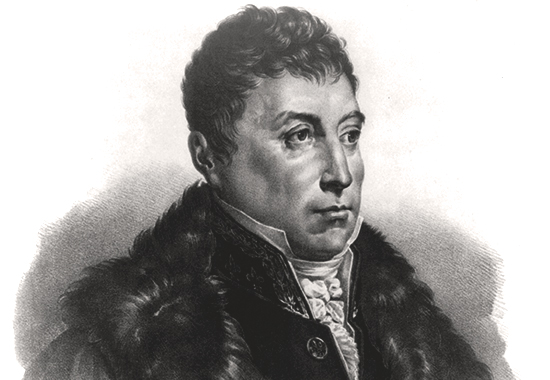
Lafayette 1757-1834 — the Hero of Two Worlds
The Man With
"Great Zeal to the Cause of Liberty"
Lafayette was, in full,
Marie-Joseph-Paul-Yves-Roch-Gilbert du Motier,
the Marquis de Lafayette,
which you can also spell La Fayette.
|
|
Image
Above
Gilbert du Motier,
Marquis de Lafayette
Lithograph
Library of
Congress |
The Marquis de
Lafayette in a Nutshell
Lafayette supported the abolition of the slave trade,
abolition of social privileges, freedom of religion, freedom
of speech, and human
rights in general.
After helping out in the
 American Revolution
against Britain, Lafayette tried to assist France in her
transformation from absolute monarchy to constitutional
monarchy. But events took a radical turn and Lafayette fled
the country in August 1792.
American Revolution
against Britain, Lafayette tried to assist France in her
transformation from absolute monarchy to constitutional
monarchy. But events took a radical turn and Lafayette fled
the country in August 1792.
Arrested by the Prussians, Lafayette
was transferred to the Austrians, who kept him
prisoner until 1797.
After his release, he tried to
prevent, or at least moderate, his country's government's
relapse into autocracy.
During intervals of political rest, Lafayette loved to
occupy himself with improving agriculture on his 200 ha /
500 acres. He also purchased several farms in the
neighborhood and exchanged letters on this topic with scientists and
inventors. In fact, he was the first
one to successfully cultivate alfalfa in the Brie region.
Early Years and
Family
Lafayette was born on September
6, 1757, at Chavaniac, France, into an ancient noble family.
Chavaniac is today's Chavaniac-Lafayette,
postcode 43230, département Haute-Loire, région
Auvergne, France.
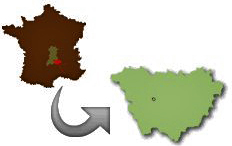
France,
Auvergne, Haute-Loire, Chavaniac
Mairie de Chavaniac Lafayette
Lafayette's father died when he
was 2 years old. His mother died when he was 13 years old.
In 1773, sixteen year old Lafayette
married Marie-Adrienne Françoise de
Noailles, second daughter of the
Duc
d'Ayen, and his wife
Anne Louise Henriette d'Aguesseau, Duchesse d'Ayen, in a pre-arranged marriage.
The couple had four children:
Henriette,
born 1775, died 1777
Anastasie,
born 1777, died 1863
Georges Washington
Louis Gilbert, born, 1779, died
1802
Georges had a son, Oscar, born 1815, died 1881
Virginie,
born 1782, died 1849
Virginie had a son, Jules, born 1810, died 1883
Wife
Marie-Adrienne lived from 1759-1807.
American
Revolution
On April 19, 1775, the
 American
Revolution broke out.
American
Revolution broke out.
On May 2, 1776, Louis XVI
signed a secret aid deal, sending arms to the American revolutionaries.
(see also
 Vergennes)
Vergennes)
On June 27, 1777, Lafayette arrived
at Philadelphia to fight against the British. He was made
major general by Congress. The legislation read as
follows,
"Whereas, the
Marquis de la Fayette, out of his great zeal
to the cause of liberty, in which the United
States are engaged, has left his family and
connexions, and, at his own expence, come
over to offer his service to the United
States, without pension or particular
allowance, and is anxious to risque his life
in our cause,
"Resolved,
That his service be accepted ... [and that
he] have the rank and commission of major
general in the army of the United States."
On August 1, 1777, Lafayette met
 George
Washington for the first time.
George
Washington for the first time.
On September 11, 1777, Lafayette fought
in the
 Battle of Brandywine. This was Lafayette's first
action in the American Revolution. Although suffering a leg
injury, he fought well, which was noticed by George Washington.
Battle of Brandywine. This was Lafayette's first
action in the American Revolution. Although suffering a leg
injury, he fought well, which was noticed by George Washington.
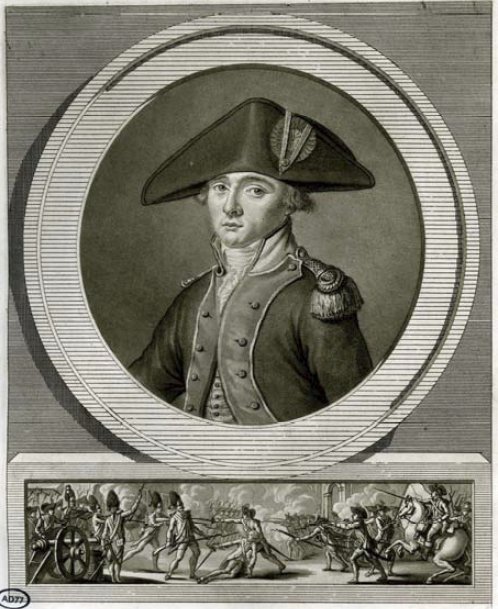
Portrait of
General La Fayette and the Battle of Brandywine, 1777
Archives
départementales de Seine-et-Marne
Lafayette was invited to attend
the negotiations with the Six Nations (Iroquois Confederacy)
in 1777 / 1778.
Battle of Barren Hill near
Valley Forge: On May 28, 1778, retreat from
Barren Hill.
Back to France in 1779. Georges
Washington gave Lafayette the task to convince the French
government to send troops. Lafayette met with
 King Louis XVI at
Versailles and was given an army.
King Louis XVI at
Versailles and was given an army.
The French troops, led by
Jean-Baptiste-Donatien de Vimeur,
Comte de Rochambeau, landed at Rhode Island in April 1780. Lafayette
was made commander of an American division.
He fought with Washington at the
 Siege of Yorktown, September 28 - October 19, 1781.
Siege of Yorktown, September 28 - October 19, 1781.
Fighting ended when
Cornwallis
surrendered on October 19, 1781. Lafayette was only 24 years
old and had established himself as able military commander.
He was celebrated as national hero.
Lafayette returned to France in 1782,
where Louis XVI made him maréchal de camp.
On January 20, 1783, the
Treaty
of Versailles (preliminary articles for the
 final treaty that would
become part of the
final treaty that would
become part of the
 Peace of Paris) was
signed by England and France, recognizing the independence
of the United States.
Peace of Paris) was
signed by England and France, recognizing the independence
of the United States.
After this, Lafayette returned
twice to the States, from June 1784 until January 1785, and
from August 1824 until September 1825.
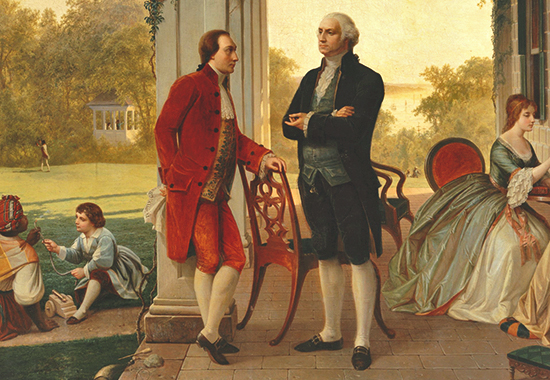
Lafayette at
Washington's home at Mount Vernon, Virginia, in 1784
(detail)
Thomas Pritchard
Rossiter and Louis Remy Mignot, 1859
Metropolitan Museum of Art
And here is Mount Vernon today,
same porch, different season:
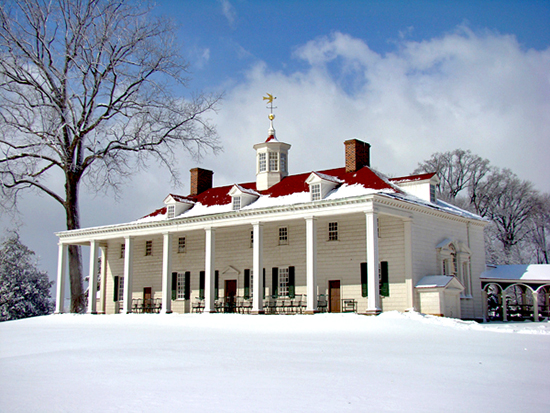
Mount Vernon
Mansion, East Lawn
Courtesy of Mount
Vernon Ladies' Association
You are welcome to
 visit Mount Vernon.
visit Mount Vernon.
Today, the U.S. keeps Lafayette
in the collective memory by having named 31 cities and 17
counties after him.
Back to Lafayette's life.
The French Revolution
The
 Assembly of the Notables,
or
Assemblée des Notables,
was held from February 22 - May 25, 1787, at Versailles. Lafayette
was summoned as one of the Notables.
Assembly of the Notables,
or
Assemblée des Notables,
was held from February 22 - May 25, 1787, at Versailles. Lafayette
was summoned as one of the Notables.
 May 10, 1787,
Lafayette asks for the
May 10, 1787,
Lafayette asks for the
 Estates General.
Estates General.
 May 23, 1787,
Lafayette's proposal in favor of Protestants is accepted by
the Assembly of Notables. In November 1787, it will bring
about the royal Edict of Toleration.
May 23, 1787,
Lafayette's proposal in favor of Protestants is accepted by
the Assembly of Notables. In November 1787, it will bring
about the royal Edict of Toleration.
On May 5, 1789,
 the States-General assembles.
Lafayette arrives as deputy from the Nobility of
Auvergne.
the States-General assembles.
Lafayette arrives as deputy from the Nobility of
Auvergne.
On July 11, 1789, Lafayette presents a draft of the
 Declaration of the Rights of Man and of the Citizen.
Declaration of the Rights of Man and of the Citizen.
On July 13, 1789, Lafayette
becomes vice-president of the
 National Constituent Assembly.
National Constituent Assembly.
July 14, 1789,
 storming of the
Bastille.
storming of the
Bastille.
On July 15, 1789, Lafayette is appointed
commander general of the National Guard.
August 26, 1789, the
 Declaration of the Rights of Man and of the Citizen
is adopted by the National Constituent Assembly after many revisions.
Declaration of the Rights of Man and of the Citizen
is adopted by the National Constituent Assembly after many revisions.
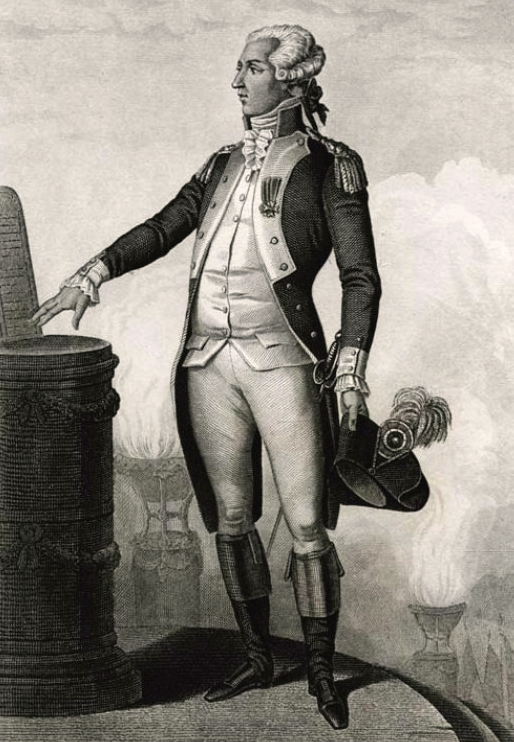
General
Lafayette with the
Declaration of the Rights of Man and of the Citizen
Archives
départementales de Seine-et-Marne
On October 6, 1789, Lafayette accompanied the
royal family from Versailles to Paris.
July 14, 1790,
 Festival of the Federation.
It was Lafayette and the mayor of Paris,
Jean-Sylvain Bailly, who
came up with the idea of organizing a day to commemorate the
Storming of the Bastille, having proposed it on June 5,
1790.
Festival of the Federation.
It was Lafayette and the mayor of Paris,
Jean-Sylvain Bailly, who
came up with the idea of organizing a day to commemorate the
Storming of the Bastille, having proposed it on June 5,
1790.
The main reason for this festival
was to demonstrate the readiness of the National Guard and
their ability to assemble with the quickness.
The
Champ-de-Mars was prepared to accommodate about 400,000
people. In the center of this enormous field was standing an
"altar of the Fatherland," ready for the priests who would
hold the Mass, the thousand singers and instrumentalists who
would let loose with Te Deum, composed for the
occasion by the then famous
François-Joseph Gossec,
who lived 1734-1829. And of course for the
oath of allegiance "to the Nation, to the Law,
and to the King," taken by Lafayette and by everyone
present.

Lafayette's
Oath at the Festival of the Federation, July 14, 1790
Le Serment de La Fayette
Oil on canvas, late
18th century, unknown painter. Wiki.
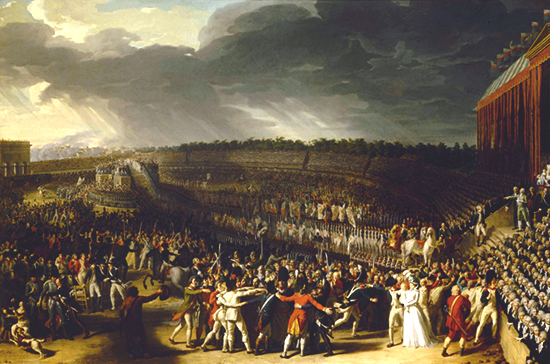
La fête de la
Fédération, le 14 juillet 1790, au Champ-de-Mars
Festival of the Federation, July 14, 1790, at the
Champ-de-Mars, Paris
Oil on canvas from 1796, by
Charles Thévenin, who lived 1764-1838
Musee Carnavalet
In 1791, for the duration of one month,
Lafayette was the president
of the National Assembly.
On May 11, 1791, at the
 National Constituent Assembly,
National Constituent Assembly,
 Lafayette speaks against the slave
trade.
Lafayette speaks against the slave
trade.
On June 21, 1791, the royal
family tried to flee the country but was caught by
Lafayette's men at Varennes and brought back. To a
suspicious mob, this raised the question whether or not
Lafayette had been involved in planning the escape in the
first place.
Club of the
Feuillants
On July 16, 1791, the Club des Feuillants
(Club of the Feuillants)
was created.
Who were the Feuillants?
The Feuillants were Reformed
Cistercians, strictly observant priests and nuns whose first
convent had been established in 1588 at Montesquiou, then it
was transferred to Toulouse in 1599. In 1622, the Feuillants
came to Paris and settled at their new convent in the Rue du
Faubourg Saint-Jacques, today's rue Saint-Jacques. The
Revolution suppressed this convent and confiscated the
building.
Moderate members of the Jacobins
made this building their new club house for their newly
established revolutionary club. The Club of the Feuillants
was in favor of constitutional monarchy and in favor of a
policy of compromise with the aristocracy.
It had come to this split when
the Jacobins, after the King's attempted escape in June
1791, argued that he had practically abdicated.
Among the founding members were
 Emmanuel-Joseph Sieyès,
Antoine Barnave,
Adrien Duport,
Alexandre de Lameth, and Lafayette.
Emmanuel-Joseph Sieyès,
Antoine Barnave,
Adrien Duport,
Alexandre de Lameth, and Lafayette.
The existence of this
revolutionary club became pointless after August 10, 1792.
Champ-de-Mars
Shooting
On July 17, 1791, Lafayette
ordered his troops to shoot at anti-royalist rioters, aka
 Champ-de-Mars Shooting
(Fusillade du Champ-de-Mars).
It became a massacre, and with many protesters died
Lafayette's popularity, and the reputation of the mayor of
Paris, Jean-Sylvain Bailly.
Champ-de-Mars Shooting
(Fusillade du Champ-de-Mars).
It became a massacre, and with many protesters died
Lafayette's popularity, and the reputation of the mayor of
Paris, Jean-Sylvain Bailly.
In a ironic way, it
reminds of Lafayette's speech before the National
Constituent Assembly, addressing the King:
"The national guards of France swear to your
Majesty an obedience that shall have no
limit but that of law, an affection that
shall have no end but that of life."
Lafayette,
July 13, 1790
In October 1791, Lafayette resigned
as commander of the National Guard.
In December 1791, Louis XVI made him commander of
the Army of the Center. Lafayette was ready to fight
against Austria.
War of the First
Coalition
On April 20,
1792, the French declared war on Austria. The
 French Revolutionary Wars
began.
French Revolutionary Wars
began.
June 20, 1792, invasion of the Tuileries Palace. After this incident, Lafayette hastens to
get to Paris to defend the royal couple against the Jacobin
revolutionaries. He offers to stop the riots with his army,
but Marie-Antoinette persuades
Louis to refuse.
In July 1792, Lafayette was made commander of
the Army of the North.
August 10,
1792, storming of the Tuileries. This time for good. Overthrow of the monarchy. France is now a
republic. Lafayette, who had been fighting for a constitutional monarchy,
decided that this revolution was no longer his.

Marie Joseph
Paul Yves Roch Gilbert Mottier, Marquis de la Fayette
Deer-in-headlights-portrait by Henry Scheffer
Versailles
Arrest and
Prison
Declared a traitor
of the nation on August 18, 1792, Lafayette
fled the country direction Liège on the night of August 19 /
20, 1792. ( Dumouriez became his
successor as commander of the Army of the North.) The Prussians arrested him and transferred him later to the Austrians.
Dumouriez became his
successor as commander of the Army of the North.) The Prussians arrested him and transferred him later to the Austrians.
The Austrians kept him prisoner
from 1794 to 1797 at Fort Olmütz. From 1795, Lafayette's
family joined him in captivity.
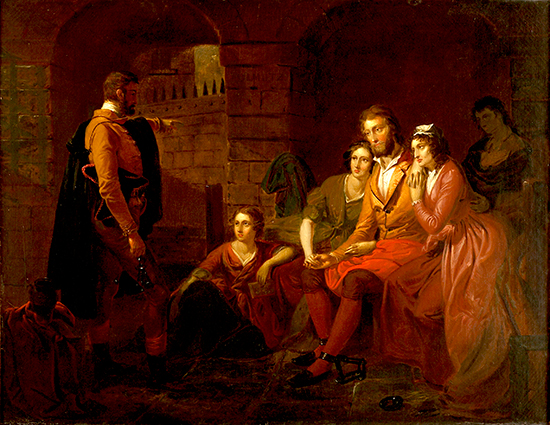
Lafayette in
Prison at Olmütz, 1795-1797
Oil on canvas by
Tompkins Harrison Matteson, 1850
Courtesy of the
Lafayette College Art Collection
Lafayette's former aide-de-camp,
Louis Leboeuf,
approached
 Bonaparte and General Clarke, who in turn
obtained from the Austrians the release of the Lafayette family on September 19,
1797.
Bonaparte and General Clarke, who in turn
obtained from the Austrians the release of the Lafayette family on September 19,
1797.
After his release from prison, Lafayette spent two years in Holland. He
was not allowed back into France yet, out of fear he would
rally the constitutional royalists again.
October 17, 1797 -
 Peace of Campo Formio,
which was the end of the
Peace of Campo Formio,
which was the end of the
 War
of the First Coalition. War
of the First Coalition.
November 9-10, 1799 - Napoleon's
Coup of 18-19 Brumaire, which was the end of the
 French
Revolution.
French
Revolution.
La Grange-Bléneau
A few days later, the Lafayette
family arrived back in France from Holland. They settled in
Seine-et-Marne, one car-hour south-east of Paris, where
Lafayette's wife Marie-Adrienne had a little castle.
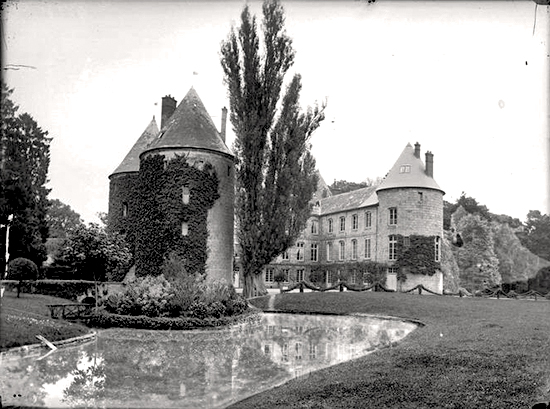
Château
de La Grange-Bléneau
located between Courpalay and Rozay-en-Brie, Seine-et-Marne,
Île-de-France
Photographer Gustave
William Lemaire. Ministère de la Culture.
On December 14, 1799,
Lafayette's friend
 George Washington died at Mount Vernon,
Virginia.
George Washington died at Mount Vernon,
Virginia.
Napoleon's brother, Joseph Bonaparte, and Lafayette became
friends. This helps Lafayette to get his name off the list of
emigrants, and to get a military retirement pension.
Lafayette's son,
Georges,
became an officer in a hussar regiment.
Lafayette opposed pretty much
everything Napoleon did, but he kept a low profile and
refused to accept tasks, posts, or awards.
On one day in 1803, leaving the Marine
Department at Paris, Lafayette slipped on ice and fractured the
femoral neck. He had to use a cane from then on.
On December 24, 1807,
Lafayette's wife died at the age of 48.
Bourbon Restoration
In 1814,
 Louis XVIII became
king, ending Napoleon's empire.
Louis XVIII became
king, ending Napoleon's empire.
In 1815, Napoleon was back for
the
 Hundred Days (March 20 - July 8, 1815). During the
Hundred Days, Lafayette was conseiller general, top
adviser, for
Seine-en-Marne.
Hundred Days (March 20 - July 8, 1815). During the
Hundred Days, Lafayette was conseiller general, top
adviser, for
Seine-en-Marne.
In addition to this post, on May 10, 1815, Lafayatte became elected
deputy for the arrondissement of Meaux. With
interruptions, Lafayette was six times re-elected for Meaux,
here are the mandates:
May 10 - July
13, 1815
November 13,
1822 - December 24, 1823
June 23, 1827
- November 5, 1827
November 18,
1827 - May 16, 1830
July 13, 1830
- May 31, 1831
July 6, 1831 -
May 20, 1834 (his death)
In October 1817, Lafayette was
elected deputy of the département of Sarthe. He kept this post until 1822.
Lafayette was very much against the
Bourbon Restoration, including their excessive spending, and
began to plot against the King, who in turn tried to monitor
him closely.
In June 1820, the affaire de
Vincennes took shape. It was planned to abduct the royal family
with the help of the garrison at Vincennes, and to
establish a provisional government. On August 10, 1820, this
coup failed.
The next coup, the affaire de
Belfort was scheduled for December 29, 1821. This time
an insurrection of the military units of
the East was plotted. The coup failed on December 23, when a sergeant of
Belfort discovered it.
The plotters were heavily penalized, but they couldn't really
pin anything on Lafayette.
After 40 years, Lafayette went back to the States in
August 1824. He stayed until September 1825 and met with
 Thomas Jefferson,
Thomas Jefferson,
 John Quincy Adams, and others.
John Quincy Adams, and others.
During Lafayette's absence, on September
16, 1824, King Louis XVIII died and Louis' brother became
 King Charles X.
King Charles X.
On October 9, 1825, at 6 PM,
Lafayette arrived back home at La Grange-Bleneau where 4,000
people came to cheer his return. The general public was
happy to see him again. The royal gendarmerie not so much.
They were back to double shift.
In June 1827, Lafayette took up
again parliamentary work.
The autocratic reign of
 Charles X led to the
Charles X led to the
 July Revolution of July 27-29, 1830.
July Revolution of July 27-29, 1830.
Charles X abdicated on August 2,
1830.
Under the
Citizen King
Lafayette officially supported the new king,
 Louis-Philippe, also called
the Citizen King, with
the words:
Louis-Philippe, also called
the Citizen King, with
the words:
Voilà le Prince qu’il nous faut.
C’est la meilleure des Républiques !
Here is the
Prince that we need. This is the best of the Republics!
On August 16, 1830, Lafayette was appointed commander general
of the National Guard.
But he wouldn't stay for long in
this position. Louis-Philippe became more and
more autocratic. In December 1830, in Lafayette's absence,
the king eliminated the post of commander of the National
Guard.
Lafayette became a leader of the opposition.
Lafayette's last political deed
was his letter, dated May 1, 1834, to the president of the
Société d’Émancipation des Noirs, the Society of Black
Emancipation, in which he encouraged their ultimate liberation.
Lafayette died on May 20, 1834, at Paris.
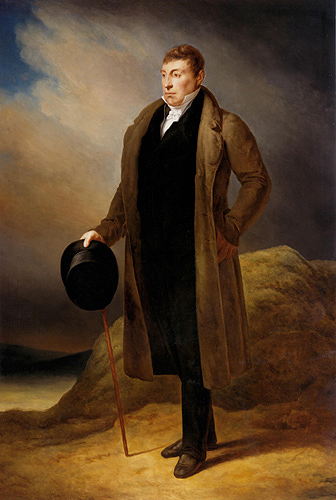
Portrait of
Lafayette 1757-1834
Oil on canvas by Ary
Scheffer, 1823
U.S. House of
Representatives
See also
 French Revolution.
French Revolution.
And
 French Revolutionary Wars.
French Revolutionary Wars.
More History
|